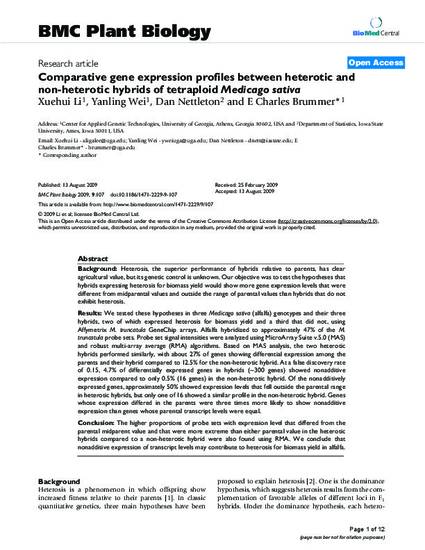
Background: Heterosis, the superior performance of hybrids relative to parents, has clear agricultural value, but its genetic control is unknown. Our objective was to test the hypotheses that hybrids expressing heterosis for biomass yield would show more gene expression levels that were different from midparental values and outside the range of parental values than hybrids that do not exhibit heterosis.
Results: We tested these hypotheses in three Medicago sativa (alfalfa) genotypes and their three hybrids, two of which expressed heterosis for biomass yield and a third that did not, using Affymetrix M. truncatula GeneChip arrays. Alfalfa hybridized to approximately 47% of the M. truncatula probe sets. Probe set signal intensities were analyzed using MicroArray Suite v.5.0 (MAS) and robust multi-array average (RMA) algorithms. Based on MAS analysis, the two heterotic hybrids performed similarly, with about 27% of genes showing differential expression among the parents and their hybrid compared to 12.5% for the non-heterotic hybrid. At a false discovery rate of 0.15, 4.7% of differentially expressed genes in hybrids (~300 genes) showed nonadditive expression compared to only 0.5% (16 genes) in the non-heterotic hybrid. Of the nonadditively expressed genes, approximately 50% showed expression levels that fell outside the parental range in heterotic hybrids, but only one of 16 showed a similar profile in the non-heterotic hybrid. Genes whose expression differed in the parents were three times more likely to show nonadditive expression than genes whose parental transcript levels were equal.
Conclusion: The higher proportions of probe sets with expression level that differed from the parental midparent value and that were more extreme than either parental value in the heterotic hybrids compared to a non-heterotic hybrid were also found using RMA. We conclude that nonadditive expression of transcript levels may contribute to heterosis for biomass yield in alfalfa.
Available at: http://works.bepress.com/dan-nettleton/83/

This article is published as Li, Xuehui, Yanling Wei, Dan Nettleton, and E. Charles Brummer. "Comparative gene expression profiles between heterotic and non-heterotic hybrids of tetraploid Medicago sativa." BMC Plant Biology 9 (2009): 107. doi: 10.1186/1471-2229-9-107.